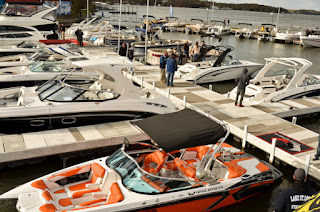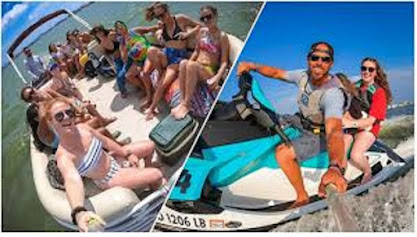Too Fast For Conditions"
LAKE OF THE OZARKS, Mo. -- An Illinois man is dead after being thrown overboard from a Cigarette boat at the 8-Mile Marker.
According to the Missouri State Highway Patrol, Timothy R. Ridens, 41, of Staunton, Ill., was driving the 1994 Cigarette "too fast for conditions" at 6:45 p.m., Friday, July 29, when the vessel hit a wake, ejecting Ridens and injuring multiple occupants.
Our thoughts and prayers are with the family.
Safe boating is the aim of all boaters and comes from education/training and experience. This excerpt from a recent Boating Statistics report, provided by the United States Coast Guard, is presented in the interest of safety by helping boaters learn from the experience of others.
FATALITY RATE
Historically, one indicator of safety in recreational boating is the fatality rate, e.g., the number of reported fatalities as compared to the number of registered recreational boats.
the Coast Guard counted 5,265 accidents that involved 767 deaths, 3,191 injuries and approximately $62.5 million dollars of damage to property as a result of recreational boating accidents.
- The fatality rate was 6.5 deaths per 100,000 registered recreational vessels.This rate represents a 25% increase from the 2019 fatality rate of 5.2 deaths per 100,000 registered recreational vessels.
- Compared to 2019, the number of accidents increased 26.3%, the number of deaths increased 25.1%, and the number of injuries increased 24.7%.
The good news is that the number of boating-related injuries and deaths has dropped considerably in the past two decades. However, according to the U.S. Coast Guard, last year, there were 626 fatalities (including 22 children under 13) and 2,613 injuries.
Some of the facts surrounding the fatal accidents last year shed light on how boating can be made safer. Where the data was known:
— Over 70 percent involved operators who lacked safety training.
— The leading cause of death was drowning (76 percent), and 85 percent of those victims weren’t wearing life jackets
— Open motorboats had the highest percentage of fatalities (46 percent).
Many of the fatal accidents were caused by the operator of the boat. Chief among those was alcohol use. That was followed by operator inattention and lack of experience, excessive speed, improper lookout and drug use.
Where the environment played a role, hazardous waters, where the operator is not operating the boat to the conditions, were by far the most common cause. That was followed by weather. Improper loading or overloading of the boat were factors in some fatal accidents, as were machinery and equipment failure.
“I didn’t see them coming” is too often the explanation for a boating crash— and it’s no surprise. As the operator, you have to constantly pay attention to numerous things: your vessel, your passengers, other boats, jet skiers, swimmers, kayakers, and submerged objects, to name a few.
According to the USCG, operator inattention and improper lookout were the top two contributing factors of boating accidents,
One of the top five causes of boating accidents is excessive speeding or not adjusting the speed to the waterway conditions. In 2020, speeding was the culprit behind 418 accidents, 32 deaths, and 345 injuries.
Unlike highways, there are no numerical speed limit signs on the water, so boaters must understand how to operate the vessel at a safe speed and keep a healthy distance from other lake-goers.
In fact, driving a boat at high speeds can be more dangerous than speeding in a car because it takes more time to stop or change direction in the water. When boaters drive at reckless speeds, it can result in collisions or rollovers, leading to costly damage and death.
Boaters should use common sense and maintain a speed that considers visibility, traffic, and weather conditions. While it may be fun to jet across the water, boating at a safe speed will ensure the operator has the time and stopping distance it takes to avoid a collision
What can be Done?
- If you are a new boater or limited boating skills.. Take boating lessons, learn navigation rules.
- Don't boat while using drugs and alcohol.. Have a designated driver
- Wear a life jacket
- File a Float Plan
- Perform regular vessel maintenance
- Have a Vessel Inspection.. provided free by the United States Coast Guard Auxiliary
- Limit boat speed to the conditions of the water, weather, and amount of boat traffic.
- Have a look out
- Be prepared for the unexpected





This article is in extremely poor taste. Unless you were personally on the boat, how can you even begin to speculate how this could have been avoided. Also, I have no doubt, whatsoever, that you did not know Tim. You clearly are ignorant to the fact that he was one of the safest boaters I’ve ever known. Accidents happen. And to post this 24 hours after his passing is inexcusable. You should be ashamed of yourself. I pray that his family and close friends do not stumble upon this poor excuse for a well-written and informative article.
ReplyDeletePoor old Tim would probably still be around if he was a safe boater. Just saying!!💁
DeleteThe handcuffs in the picture seem a bit out of place
ReplyDeleteThings can go wrong at all firms of speed all of that is related to the boat in question
Handcuffs is out of line. The person is dead
DeleteMost of the article is okay. The main channel is dangerous at most speeds now. Wakes are killers. But we still have wake ski boats.
The main channel has become a quanlet for many boaters especially anyone with a boat under 30 ft in length. The Osage can be quite tricky with waves coming at you in all directions. Even at moderate speeds the lake can be a rough ride for smaller boats.
ReplyDeleteYour correct about a couple of things, boats being under 30' is definitely a rough and bumpy ride. Yes the waves and wakes come from all directions and is very tricky especially during tourist season weekends especially. The thing you're incorrect about, this is Lake of the Ozarks which is much more narrow, longer, and way more many coves with many fingers off those covers, this is not Osage Lake, that's in Kansas. Compare the two lakes, you'll understand much better why this lake is so much more difficult to navigate.
DeleteRidiculous how the big cruisers make the big waves some can definitely be avoided should be allowed to plow like they do makes it unsafe for smaller boats!!!
ReplyDeleteShouldn’t be allowed to plow like they do
ReplyDeleteSo what happened to the Captain of the vessel that made the wave? You are responsible for your wake!
ReplyDelete